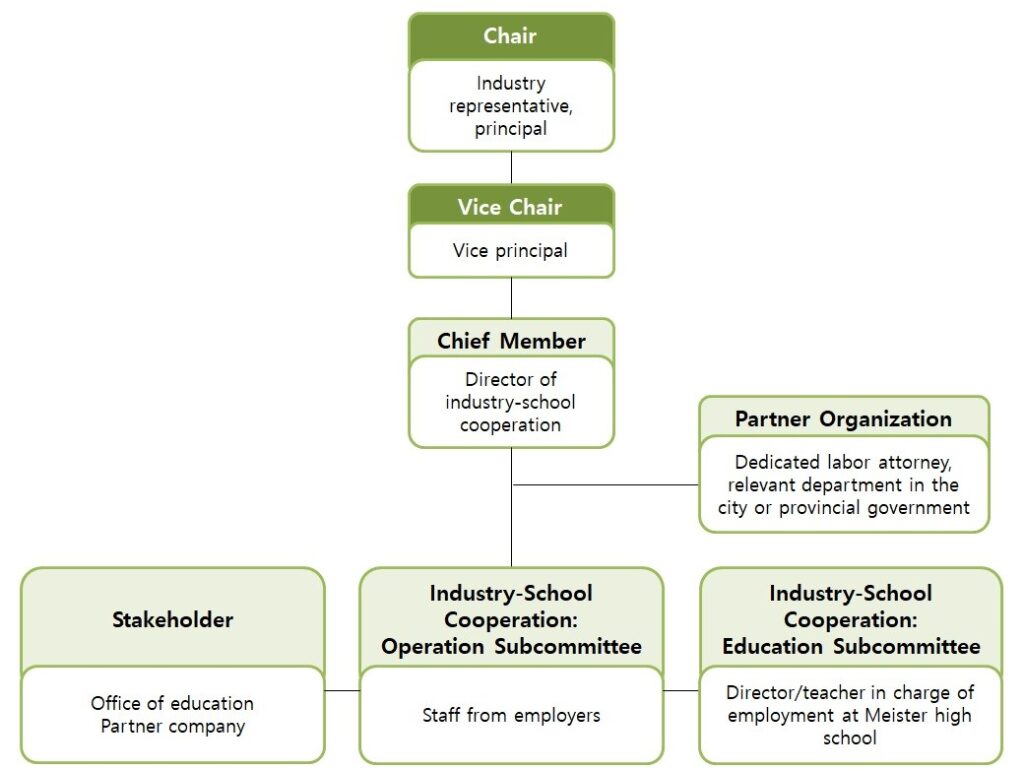Like in other countries, South Korea’s traditional technical and vocational schools have been struggling to attract prospective students due to concerns about the lack of guarantee for decent jobs and career stability after graduation. Students often have difficulty finding a job immediately after graduation and are often poorly treated by companies. The industry-school partnership programs were also often regarded as perfunctory, leading to establishing less systematic programs. To tackle the issue, the South Korean government introduced Meister High Schools in 2008, encouraging students to develop their careers in the fields that they have chosen based on their aptitudes and interests.
Meister high schools aim to empower students to develop and continue their careers by securing decent jobs for them, allowing them to further pursue a college education while working. This initiative achieved graduated students’ employment rates of more than 90% between 2013 and 2017 before the COVID-19 pandemic, and the rates fell to 75% after the pandemic.
What is Meister High School?
Meister high schools are high-performing vocational high schools that provide tailored curriculums directly connected to industry demand for professional vocational education development. Among specialized vocational high schools, 21 outstanding schools were selected and designated as Meister high schools and began their operation in 2010. As of 2022, 54 schools are recognized as Meister high schools, of which 53 are in operation.
Meister High Schools’ Impacts
McKinsey Global Institute and the Economist recognized Meister high schools as a prime example of vocational education for the following successes that they have achieved.
High Employment Rate
A major success of Meister high schools is its contribution to developing a technical workforce tailored to industries’ demand and ensuring a successful transition of students from schools to the labor market. Meister high schools achieved more than 90% employment rates between 2013 and 2017. Due to COVID-19, the employment rate of Meister high school graduates fell to 75.0% in 2021. However, it is still higher than that of specialized vocational high school graduates (53.4%) or vocational class in general high school graduates (35.9%).
Employment Status of Graduates from Meister High Schools (2013-2017)

Employment Status of Graduates from Vocational Track at Secondary Level (2021)

Successful Transition into the Labor Market
Most graduates landed full-time jobs. The proportion of full-time employees among Meister high school graduates was maintained at 98.7% in 2015. Also, employers are highly satisfied with the Meister high school graduates and intend to keep hiring them in the future. Employers have highly appreciated the performance level of the Meister high school alumni. A survey conducted in 2019 found that companies rated graduates’ competencies an average of 5.27 out of 6.
Companies’ Satisfaction with Competency Level of Meister High Schools Graduates

Source: A survey conducted on 21 Meister high schools opened in 2010 is summarized. KRIVET internal data as of 2019.
Changing the Perception of Vocational Education
As both the quantity and quality of employment opportunities for high school graduates have increased, Meister high schools have substantially contributed to reversing the unfavorable perception of secondary vocational education. Moreover, Meister high schools have also created an environment where companies transform their personnel and compensation systems from degree-based to merit-based.
Problem: Why was the demand for Meister high schools so high?
South Korea’s traditional Vocational high schools have faced challenges in attracting prospective students because of the student’s concerns about their post-graduation career security. Issues included a mismatch between school and industry and the tendency in students to avoid employment after graduation and pursue post-secondary education.
A Mismatch Between School and Industry
The school curriculum that did not actively reflect the rapidly changing needs of industry led to a gap in between the skillsets students achieve at schools and the skillsets needed at job positions in industries. Moreover, students did not have confidence in their career paths due to perfunctory industry-school partnership programs that failed to render them skillful and employable.
High College Entrance Rate and Low Employment Rate for Vocational High School Graduates
Poor treatment by companies in terms of compensation and work conditions caused students to become hesitant to find a job or caused them to blindly seek a college education rather than looking for employment. Specialized vocational high school graduates showed a high college enrollment rate (73.5%) but a very low employment rate (16.7%) (Statistical Yearbook of Education, 2009).
Solution: Meister High School, a New Model for Vocational High Schools
The South Korean government proposed a “Plan to Develop Korean-style Meister High Schools” to solve these problems as a new model for vocational high schools. Meister high schools aim to provide students with aspirations and visions to become experts in their chosen fields based on their aptitude and interest.
The Status of Meister High Schools in the South Korean Education System
Korea’s school system consists of six years of elementary school, three years of middle school, and three years of high school, followed by post-secondary education. In Korea, high schools are divided into non-vocational high schools (academic track)1 and vocational high schools (vocational track). To follow the vocational track, students can choose specialized vocational high schools,2 Meister high schools, or vocational classes in general high schools.
Status of Korea’s Vocational High Schools, 2021.
(Unit: schools, %)

Source: Korean Educational Development Institute (KEDI) (2020). Statistical Yearbook of Education. https://kess.kedi.re.kr/
As of 2021, among 2,375 high schools, there are 540 vocational high schools (including specialized vocational high schools and Meister high schools) in Korea, and there are 52 Meister high schools, accounting for 2.2% of all high schools. The number and percentage of Meister high schools has increased consistently yearly from 40 schools (1.7%) in 2015 to 52 schools (2.2%) in 2021.
Characteristics of Meister High School
The following characteristics originated and vitalized more in Meister high schools, but they are currently benchmarked and spread to specialized vocational high schools. In a strict sense, only the certificate system and industry-school cooperation committee are exclusive to Meister high schools.
“Work-First, Study-Later”(University Entrance after Employment)
It is required for Meister high school graduates to work for at least three years following graduation. A “Work-First, Study-Later” program provides students with opportunities to combine work and study to obtain a job after graduating from high school and continue to develop their careers and skills based on field experience. There are numerous avenues for them to pursue their academic development, such as special university admission for incumbent employees, industry contract departments, industry-commissioned education, and online institutions.
Curriculums Tailored to Demands from Industries
Meister high schools have greater autonomy in organizing curriculums than specialized vocational high schools. The mismatch between what vocational high schools train the students for and the demands of industries can be resolved with a flexible curriculum system in which a curriculum is developed and operated to meet the rapidly changing needs of industries. To accomplish this, an Industry-School Cooperation Committee has been set up to reflect the changing demands from industries to the school curriculum.
An Example of Changes at an Electronic Meister High School

After-School Programs
Meister high schools offer after-school programs. The after-school programs have evolved into different models and are active nationwide. The programs strengthen the educational effect by aligning its objectives with the official curriculum provided by the government and tapping into various community resources.
Project-Based Learning
Meister high schools incorporate project-based learning experience into their curriculum to build students’ ability to identify and solve problems independently. To develop project-based learning competencies in teachers, a conference to present the best practices of project-based learning is held every December. In addition, a faculty of project-based learning developers and experts provide training for teachers to share representative examples.
The Procedure of Project-Based Learning

Source: Yu et al. (2022). Meister High School System 2021, p.29.
Graduate Certification System
Schools set the standards that students are expected to meet until graduation, encourage them to reach the standards, and award a certificate to those who have achieved such level upon graduation. The certificate includes students’ vocational basic competency, professional competency, foreign language ability, IT skills, and personality. For example, in a Meister high school focusing on agriculture, students’ professional competency is evaluated through agricultural field practice, project work, portfolio, and related national technical qualifications. This system is not yet recognized by industry, but it strengthens educational accountability at the school level.
Dormitory Accommodation
Meister high schools dormitories align with the educational policy of “opening more competent schools with diversity.” The schools operate dormitories to enable students in rural or remote villages to attend schools with qualified teachers and programs without the difficulty of commuting to the urban area.
Strong Industry-School-Government Cooperation
The industry-school-government (both central and local) cooperation system was established to enable Meister high schools to rapidly detect and actively respond to industry changes and effectively nurture core talents for national and local strategic sectors through their linkage with relevant ministries.
School-Specific Industry-School Cooperation Committee
Each school has its own industry-school cooperation committee. The committees aim to create job opportunities at partner companies, operate programs to strengthen students’ employability, and provide students with job-hunting guidance customized to different types of employers.
Organization Model of Meister High School Industry-School Cooperation Committee

Source: Yu et al. (2022). Meister High School System 2021, p. 40.
Moving Forward: Concluding Thoughts
Twelve years after the establishment of the Meister high schools, South Korea currently operates 53 Meister high schools, with each school’s specialty area becoming increasingly diverse and industry responsive. Significant traits of Meister high schools can be summarized as follows:
- Developing and operating a curriculum tailored to industry demands.
- For after-school programs.
- Project-based learning experience.
- Graduate certification systems.
- Dormitories.
- Active industry-school cooperation.
In Meister high schools, we have observed a high employment rate, higher salaries, and high school education satisfaction among stakeholders. Graduates’ job satisfaction is also higher than those of other vocational high schools. Many Meister high schools have actively been involved in industry-school cooperation, providing firms significant opportunities to develop industry-tailored talents and ultimately contributing to the regional economy in the long run.
However, additional efforts are required. First, the schools should continue to provide sustainable employment in stable small and medium-sized enterprises. Second, the schools must support graduates’ career paths based on today’s fast-changing industries. Thirdly, the committees in charge of industry-school-government cooperation should make additional efforts to identify reputable partner companies. Fourth, the school departments and curriculums need to continuously meet the rapidly changing demands of industries. Fifth, the schools should work closely with offices of education and government ministries to secure financial support systems. Lastly, the schools must seek ways to develop a lifelong career path for graduates in their respective areas of expertise.
The Meister high school model may have implications for Latin America and the Caribbean, where the academic track in secondary education is more prioritized than the vocational track, as is the case in South Korea. South Korea’s Meister high school model has demonstrated that vocational education’s success depends on quality education, systematic management of students, in-depth career guidance for the students, and active cooperation between schools, industries, and governments.
While comparative studies on the TVET across countries may be helpful (e.g., Amaral et al., 2017), the model can provide insights for the governments in Latin America and the Caribbean to manage their vocational education systems.
What lessons from the Meister high school model are useful for Latin America and the Caribbean? Leave your comments below.
The post Meister High Schools: The South Korean Model to revitalize technical and vocational education appeared first on Enfoque Educación.
